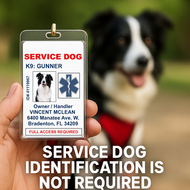Service Dog Identification Is Not Required — Here’s Why Many Wear It
Posted by WorkingServiceDog on Jun 1st 2024
Service Dog Identification Is Not Required
You spot the sign on the door: “No Pets.” A staffer is already looking your way. That little “here we go” feeling hits. Most of us have been there—hoping this trip doesn’t turn into a scene at the entrance.
The law, super quick
Under the Americans with Disabilities Act (ADA), you do not have to show paperwork, an ID card, or a vest. If your disability isn’t obvious, staff can only ask two things:
- Is the dog a service animal required because of a disability?
- What work or task has the dog been trained to perform?
That’s it—no medical records, no “proof,” no task demonstrations.
So why do people still stop me?
Real life is messy. Busy employees see a dog and think “pet.” New managers don’t know the rules. You end up explaining yourself in the doorway while everyone watches. It’s stressful and it gets old fast.
Two ways to handle that moment
- Verbal only (100% legal): Answer the two ADA questions and keep moving. Many teams do this and it works fine.
- Use visual cues (optional, but practical): A clean vest, clear patches like “Working Dog — Do Not Pet,” an ADA info card, or a simple photo ID can settle nerves fast and prevent back-and-forth at the door.
What a lot of teams carry by choice
- Service dog vest for instant recognition
- Service Dog Patches to reduce interruptions
- ADA info cards to hand a staff member who’s unsure
- Handler/dog ID badge for quick, no-drama interactions (not required by law)
None of these are required. They’re just tools to keep your day simple.
A short script you can use
“This is my service dog. Under the ADA you can ask two questions: if the dog is required because of a disability and what task the dog performs. My dog is trained to [brief task]. We’re good to go.”
Your call, your comfort
Some handlers stick with verbal assurance only. Others prefer a vest and an info card to avoid confrontations. There’s no wrong choice—know your rights, and use whatever helps you walk through the door with confidence.

